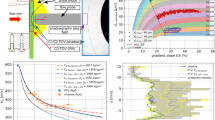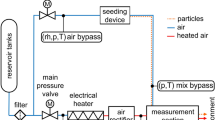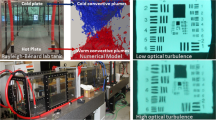Abstract
Measurements have been made of the effect of flow turbidity on the visibility and pedestal amplitude of an anemometer signal when incident laser beams are interrupted by particulate flow. The purpose is to assess the likely accuracy of particle sizing and the reliability of discrimination between continuous and particulate phase velocities. Optical depths of field were varied between 2.5 × 10−2 and 14 × 10−2 mm the diameter of the interrupting particles ranged between 14 and 800 μm in six discrete ranges and the corresponding void fractions lay between 0.003% and 0.378%. The incident beam diameter was approximately 400 μm.
The measured size is subject to both systematic and random errors when inferred from measurements of pedestal amplitude: the random error increases as the ratio of the incident beam diameter to that of the particulate phase decreases. Systematic errors corresponding to a 10% underestimation of diameter occur at void fractions of 0.003%, 0.01% and 0.018% for particles below 40 μm 75 μm and 105 μm respectively over a 5 cm depth of field. The r.m.s. error is smaller than 7% for particles below 40 μm for all conditions studied but increases with increasing diameter and exceeds 10% at void fractions greater than 0.1% for particles above about 100 μm. The random error in measured diameter derived from measurements of visibility is influenced mostly by the flow turbidity over the 5 cm of the incident beams closest to the measuring volume. For interrupting particles smaller than about 100 μm the r.m.s. error is similar to that for measurements based on the pedestal amplitude.
Discrimination of the velocity signal between the particulate and dispersed phase, based on the separation of pedestal amplitudes, is likely to be unreliable if the particle diameter is comparable to the diameter of the incident beams and if the probability of two particles simultaneously present in each beam is not negligible. A method for estimating the level of turbidity at which discrimination is no longer possible is described.
Similar content being viewed by others
Abbreviations
- b :
-
beam diameter
- d :
-
particle diameter
- D :
-
amplitude of high passed Doppler signal (equation 7)
- D 1 :
-
depth of field of water tank
- E :
-
particle extinction coefficient (= 2)
- I 1,2 :
-
instantaneous light intensity at LDA measuring volume of each incident beam
- n :
-
particle concentration (number per unit volume)
- N :
-
number of particles in the incident beam
- P :
-
maximum amplitude of pedestal component of Doppler signal
- T :
-
Transmittance of beam {(attenuated/unattenuated) beam intensity}
- V :
-
signal visibility (equation 8)
- ε:
-
relative error in measured particle diameter {(truemeasured)/true)}
- λ:
-
wavelength of laser beam (632.8 nm)
References
Adrian, R. J.; Orloff, K L. 1977: Laser anemometry signals: visibility characteristics and application to particle sizing. Appl. Opt. 16, 677–684
Bachalo, W. D. 1980: A method for measuring the size and velocity of spheres by dual beam scatter interferometry. Appl. Opt. 19, 363–370
Bachalo, W. D.; Houser, M. J. 1984: Phase/Doppler spray analyzer for simultaneous measurements of drop size and velocity distributions. Opt. Eng. 23, 583–590
Durst, F. 1973: Scattering phenomena and their application in optical anemometry. Z. Angew. Math. Phys. 24, 619–643
Durst, F.; Melling, A.; Whitelaw, J. H. 1981: Principles and practice of laser Doppler anemometry, 2nd Edition. London: Academic Press
Durst, F.; Zaré, M. 1975: Laser Doppler measurements in two phase flows. In: The accuracy of flow measurements by laser Doppler methods, pp. 403–429. Proceedings LDA Symposium, Copenhagen, Skovlunde, Denmark
Eckbreth, A.; Stufflebeam, J. 1985: Considerations for the application of CARS. Exp. Fluids 3,301–314
Faeth, G. M.; Shuen, J.-S.; Solomon, A. S. P.; Zhang, Q.-F. 1985: Structure of particle-laden jets: measurements and predictions. AIAA J. 23, 396–404
Farmer, W. M. 1972: Measurement of particle size, number density and velocity using laser interferometer. Appl. Opt. 11, 2603–2612
Hess, C. F. 1985: A technique to measure the size of particles in Laser-Doppler velocity applications. Second International Symposium on Laser anemometry, Miami. ASME FED, Vol. 33, pp. 119–125
Hess, C. F.; Espinosa, V. E. 1984: Spray characterisation with a non intrusive technique using absolute scattered light. Opt. Eng. 23, 604–609
Hodkinson, J. R. 1966: The optical measurement of aerosols. In: Davies, C. N. (ed.): Aerosol Science, pp. 287–357. London: Academic Press
Holve, D.; Self, S. 1979: An optical particle sizing counter for in situ measurements — parts I and II. J. Appl. Opt. 18, 1632–1652
Holve, D.; Self, S. 1980: Optical measurements of mean particle size in coal-fired MHD flows. Combust. Flame 37, 211–214
Holve, D.; Annen, K. D. 1984: Optical particle counting, sizing and velocimetry using intensity deconvolution. Opt. Eng. 23, 591–603
Levy, Y.; Lockwood, F. C. 1981: Velocity measurements in a particle laden turbulent free jet. Combust. Flame 40, 333–339
Modarress, D.; Tan, H. 1983: LDA signal discrimination in two-phase flows. Exp. Fluids 1, 113–120
Negus, C. K.; Drain, L. E. 1982: Mie calculations of the scattered light from a spherical particle traversing a fringe pattern produced by two intersecting laser beams. J. Phys. D 15, 375–402
Saffman, M.; Buchhave, P.; Tanger, H. 1984: Simultaneous measurement of size, concentration and velocity of spherical particles by a laser Doppler method. 2nd Intl. Symposium on Applications of Laser Anemometry to Fluid Mechanics, Paper 8.1. Lisbon
Yeoman, M. L.; Azzopardi, B. J.; White, H. J.; Bates, C. J.; Roberts, P. J. 1982: Optical development and application of a two colour LDA system for the simultaneous measurement of particle size and particle velocity. In: Engineering Applications of Laser Velocimetry, pp. 127–135. Winter Annual Meeting, ASME, Phoenix, Arizona
Yeoman, M. L.; Hemsley, D. J.; Hadded, O.; Bates, C. J. 1985: A single particle optical counting instrument for on-line simultaneous measurement of drop size, velocity and concentration in sprays and spray systems. Paper VC/1, 3rd International Conference on Liquid Atomisation and Spray Systems, The Institute of Energy, London
Yule, A. J.; Ereaut, P. R.; Ungut, A. 1983: Droplet sizes and velocities in vaporizing sprays. Combust. Flame 54, 15–22
Author information
Authors and Affiliations
Rights and permissions
About this article
Cite this article
Kliafas, Y., Taylor, A.M.K.P. & Whitelaw, J.H. Errors in particle sizing by LDA due to turbidity in the incident laser beams. Experiments in Fluids 5, 159–176 (1987). https://doi.org/10.1007/BF00298456
Received:
Issue Date:
DOI: https://doi.org/10.1007/BF00298456




